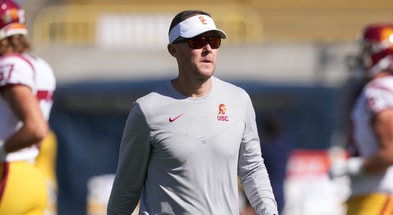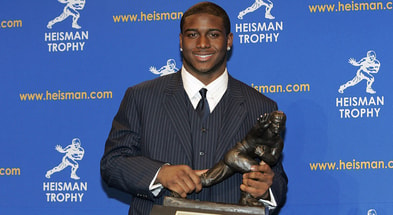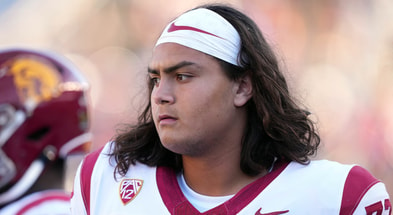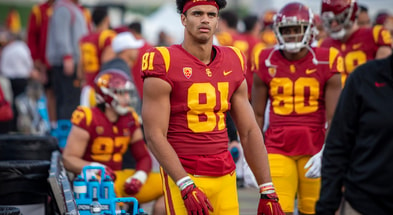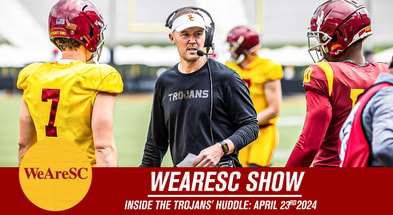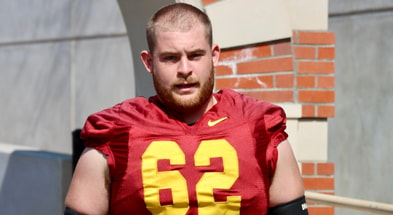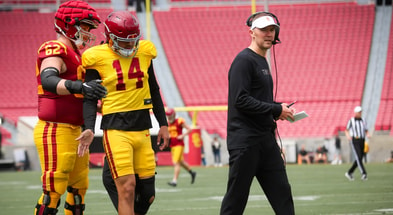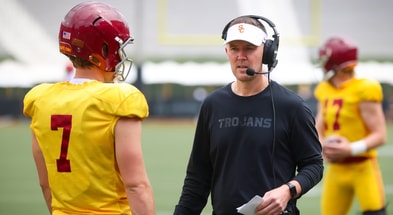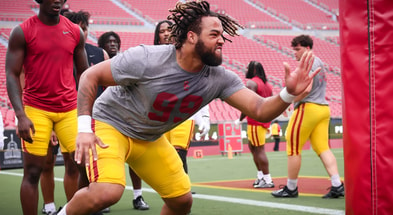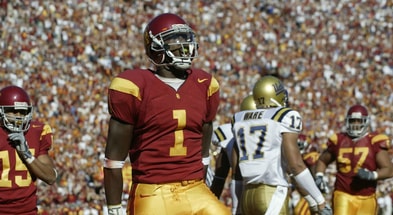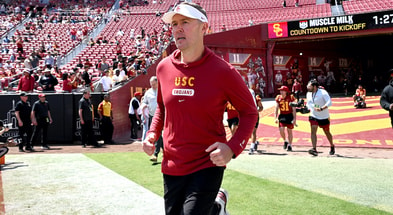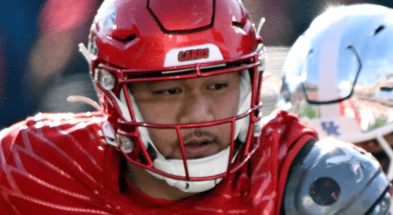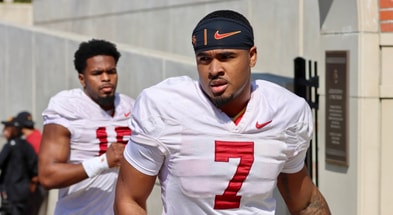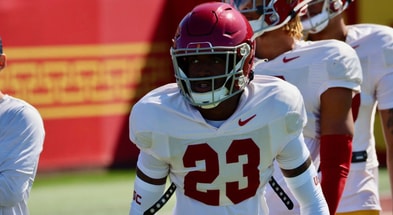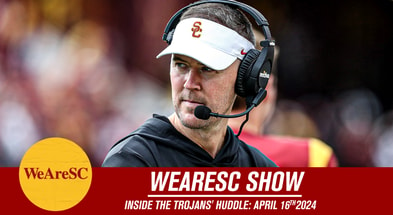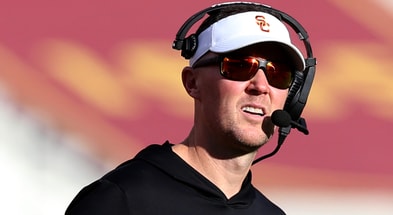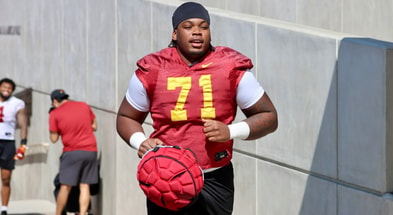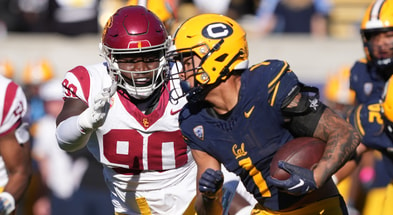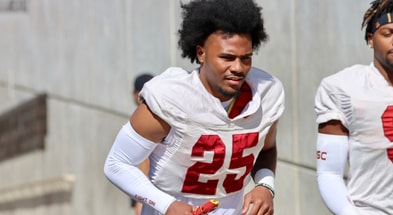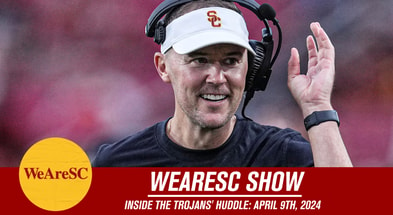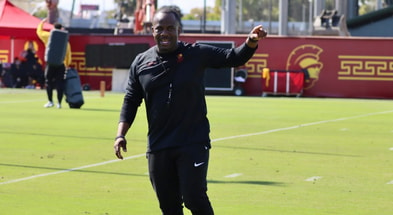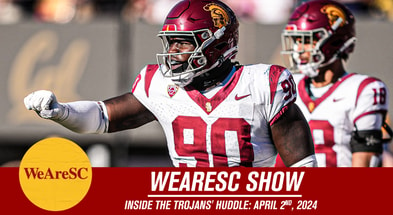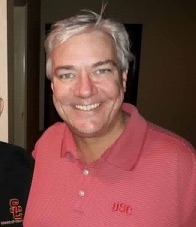Musings from Arledge: Spring Game Review and Mark Emmert Adieu
So a reported crowd of 33,000 for the spring game? It would have been 33,001 if Herbstreit would have shown up, but still not bad.
In any event, with or without Kirk, that might be the largest football crowd at the Coliseum in two years. It was certainly the most excited. Happy fans and not a single plane banner in sight.
And the fans got happier as the game went on. Because while you can’t tell everything from a spring game, you can tell something.
In the Academy Award-winning film The Naked Gun, Frank Drebin breaks into an office to investigate the man he believes is plotting to kill the queen (brilliantly played by Ricardo Montalban). Drebin being Drebin, the clandestine office search quickly breaks down into a parade of absurdities, with Drebin hopping around on one foot (with the other stuck in a trash can that is on fire) trying to catch dozens of falling, priceless vases as a player piano belts out a ragtime tune. The office ends up destroyed and Drebin finds himself on the building ledge where he unwittingly commits a, uh, crime of sorts, with a concrete object. The scene is ridiculous. And hilarious. (Warning: the link is not appropriate for some younger viewers and older viewers who have no sense of humor.)
The entire Clay Helton tenure was like that scene, except only USC’s opponents were laughing. I’m not talking just about the disastrous, blowout losses. Even the wins were parades of absurdities: blown assignments, soul-crushing penalties, absurd play-calling, frequent looks of shock and bewilderment from the guy who was supposed to be in charge, followed by a Baghdad Bob impersonation in the postgame press conference. It was awful to watch, which is why just about everybody stopped watching. And when it was over, USC football looked like Ricardo Montalban’s office: everything was broken, and you couldn’t help but be convinced that a crime had been committed.
We can’t tell definitively how USC will perform just based on a single, two-quarter spring game. But we can tell at least one thing: USC actually looks like a football team. The guys lined up correctly – that’s right; no illegal formation penalties! – they didn’t false start, they didn’t jump offsides, they didn’t hold, they didn’t continually miss their assignments, and they didn’t taunt. They played hard, aggressively, and with physicality. That’s a pretty good start.
What does it all mean? Offensively, I think we know. Barring critical injuries, the offense is going to be very, very good – probably the best in the conference and one of the best in the country. Lincoln Riley is an offensive wizard. ESPN showed a graphic during the spring game that captures just how good the guy is. In his five years at Oklahoma, OU led the nation in just about every significant offensive category.
And he has the talent to be successful from day one at USC. He has an experienced offensive line, three very good running backs, a solid group of receivers with a nice combination of size and speed, and a superstar quarterback. Yep, Caleb Williams is everything he was supposed to be. He’s young, talented, and the second richest person on campus. He’s going to be fun to watch for the next two years.
Maybe best of all, USC will run the ball. Finally! Riley has a great track record of running the football, which means we might see a return to USC’s tradition of dominant running teams. As Erik McKinney noted earlier this week – and I can’t tell you how thrilled I am to have a research assistant as talented as Erik McKinney – during Clay Helton’s full seasons as USC head coach, USC’s rushing production fell every year, from 200.7 rushing yards per game in 2016, to 185.1 in 2017, to 133.5 in 2018, to 118.2 in 2019, to 97.3 in 2020. Just think: if Pat Haden and Lynn Swann had their way and Clay got a lifetime contract, USC would be rushing for eight yards per game by the end of this decade.
Defensively? Well, we’ll see. There are still some roster limitations there, especially in the front seven. That USC defense on Saturday didn’t exactly look like Pete Carroll’s 2008 squad. But it wasn’t all bad. They have some dudes, and the group as a whole played hard and tended to be in the right position. It’s been years since we could say that. I think the roster will change on that side of the ball substantially before September, so I don’t know what we’ll see.
But I know this: when you have an offense as explosive as USC’s is likely to be, you can afford to play aggressively on defense. You’ll make some mistakes and give up some scores, but it only takes a couple of drives ended by a sack or a turnover to put the other team in a big hole. USC should attack on defense this year. If they can find a couple of disruptors up front in the transfer portal, the defense should be good enough to win a lot of games.
No, the defense won’t be Georgia good, and USC probably won’t be Georgia good. At the same time, Georgia won’t have anybody as good as Caleb Williams under center, they won’t have anybody as good as Lincoln Riley directing their offense, and therefore I don’t think Georgia’s offense will be USC good, either.
Stop. I’m not saying that. I’m not crazy. I’m not saying this year’s USC team will be as good as Georgia. I’m just saying it will be a good football team, one that we’ll actually enjoy watching for the first time in a long time.
Not everybody realizes that yet. ESPN recently used its Football Power Index to predict the upcoming Pac 12 season, and they had USC finishing fourth in the conference with eight wins. I don’t think so. I’d bet the over and feel very good about it. USC is more likely to win ten games than eight. And things should only grow from here.
There you have it. Sunshine Pumping from Musings. Like I said, it’s a brand new day.
Before I sign off, can we talk about NCAA President Mark Emmert for a minute? Emmert just announced that he’ll be stepping down in June of 2023 or sooner if a replacement is found. I assume the transition won’t happen quickly because of how long it will take to find somebody capable of filling Emmert’s shoes. Michael Scott would be perfect, but he’s a fictional character, so I assume the NCAA will scour America’s most under-performing corporations for a middle management type with no discernible skills or vision.
Emmert took over shortly before the NCAA announced draconian sanctions against USC football in the Reggie Bush scandal in a process overseen by committee chair Paul Dee, who was concurrently presiding over an out-of-control, coke-hookers-n-yachts program at the University of Miami and was horrified by USC’s lack of institutional control. Emmert then denied USC’s appeal of a process that would have made Soviet jurists blush and then proceeded to ignore the Cam Newton Auction that took place in the SEC.
The rules that Emmert selectively enforced were, of course, designed to guarantee that all of the billions generated by college football and basketball go to the right people – that is, the old guys in suits and not the kids in uniforms. On that front, Emmert was single-minded. He fought hard to keep students not only from taking any portion of the revenues they had earned for the schools but even from generating any other moneys from their fame, notoriety, and hard work. Instead, the NCAA and the schools would the sole beneficiary of players’ names, images, and likenesses as they sold jerseys with players’ names and video game rights with players’ likenesses. It was Emmert’s unflagging devotion to this vision that led the federal courts to throw out the NCAA’s name, image and likeness rules and, in a later case, have the United States Supreme Court find 9-0 Supreme Court that the NCAA violates antitrust laws, the latter case being the one in which Justice Kavanaugh came just inches from calling the NCAA a mafia crime family.
If the current NIL chaos bothers you, thank Mark Emmert. His unwillingness or inability to lead the NCAA in a fairer direction made it so the courts were no longer willing to give the NCAA the benefit of the doubt.
Emmert also showed no leadership during Covid, essentially sitting in his basement while schools and conferences tried to figure out what to do.
Emmert’s leadership was such that the NCAA is now a powerless organization that still exists only because nobody knows what to replace it with and despite the fact that just about every major college football program in the country has decided that they won’t be sticking around to see what the NCAA does next. Emmert’s work in completely destroying the organization he led is the national equivalent to Larry Scott’s work in the Pac 12 or Clay Helton’s work in Heritage Hall.
Emmert will soon be gone. He won’t be missed.
